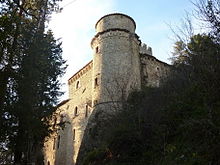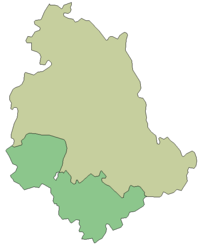Umbria
Umbria | ||
|---|---|---|
Region | ||
|
ISO 3166 code IT-55 | | |
| HDI (2021) | 0.900[2] very high · 12th of 21 | |
| NUTS Region | ITE | |
| Website | www | |
Umbria (/ˈʌmbriə/ UM-bree-ə, Italian: [ˈumbrja]) is a region of central Italy. It includes Lake Trasimeno and Marmore Falls, and is crossed by the Tiber. It is the only landlocked region on the Apennine Peninsula. The regional capital is Perugia.
The region is characterized by hills, mountains, valleys and historical towns such as the university centre of Perugia, Assisi (a World Heritage Site associated with St. Francis of Assisi), Terni, Norcia, Città di Castello, Gubbio, Spoleto, Orvieto, Todi, Castiglione del Lago, Narni, Amelia, Spello and other small cities.
Geography
Umbria is bordered by Tuscany to the west and the north, Marche to the east and Lazio to the south. Partly hilly and mountainous, and partly flat and fertile owing to the valley of the Tiber, its topography includes part of the central Apennines, with the highest point in the region at Monte Vettore on the border of the Marche, at 2,476 metres (8,123 feet); the lowest point is Attigliano, 96 metres (315 feet). It is the only Italian region having neither a coastline nor a common border with other countries. The comune of Città di Castello has an exclave named Monte Ruperto within Marche. Contained within Umbria is the hamlet of Cospaia, which was a tiny republic from 1440 to 1826, created by accident.
Umbria is crossed by two valleys: the Umbrian valley ("Valle Umbra"), stretching from Perugia to Spoleto, and the
In antiquity, the plain was covered by a pair of shallow, interlocking lakes, the Lacus Clitorius and the Lacus Umber. They were drained by the
The eastern part of the region, being crossed by many faults, has been often hit by earthquakes: the last ones have been that of 1997 (which hit Nocera Umbra, Gualdo Tadino, Assisi and Foligno) and those of 2016 (which struck Norcia and the Valnerina).[3]
In literature, Umbria is referred to as Il cuore verde d'Italia or The green heart of Italy. The phrase is taken from a poem by
History







Antiquity
The region is named for the
The Umbri probably sprang, like neighbouring peoples, from the creators of the
The
After the downfall of the Etruscans, Umbrians aided the Samnites in their struggle against Rome (308 BC). Later communications with Samnium were impeded by the Roman fortress of Narnia (founded 229 BC on the place of the umbrian Nequinum, conquered in 299 BC).[10][11][7] Romans defeated the Samnites and their Gallic allies in the battle of Sentinum (295 BC).[11] Allied Umbrians and Etruscans had to return home and defend each of their territories against simultaneous Roman attacks, leaving the Samnites without their help at Sentinum.[citation needed]
The Roman victory at Sentinum initiated a period of integration under the Roman rulers, who established some colonies, such as
During the
Modern Umbria is different from
After the collapse of the
Middle Ages
Soon after the end of the
In the early 14th century, the
Modern history
After the
After Napoleon's defeat, the Pope regained Umbria and ruled it until 1860.
The region of Umbria at the time was somewhat larger than today, comprising Rieti to the south, now part of Lazio.[20] Rieti was detached and added to the Province of Rome (Lazio) in 1923.[20] In 1927, the region of Umbria was divided into the provinces of Perugia and Terni.[20]
During WWII, the industrial centers of the region like Terni and Foligno were heavily bombed and in 1944 became a battlefield between the allied forces and the Germans retreating towards the
Economy
The present economic structure emerged from a series of transformations which took place mainly in the 1970s and 1980s. During this period, there was rapid expansion among small and medium-sized firms and a gradual retrenchment among the large firms which had hitherto characterised the region's industrial base. This process of structural adjustment is still going on.[23]
Economically the most important region is the upper Tiber valley with Città di Castello. Terni steelworks (stainless steel, titanium, alloy steel) and processing companies (automotive, stainless steel tubes, industrial food facility) account for 20 to 25% of Umbria's GDP. In Terni there are also many multinational companies in the fields of chemistry, hydroelectric power, renewable sources of energy, and textiles (Alcantara, Cashmere). In the rest of the region the ornamental ceramics industry is much esteemed.[23]
Umbrian agriculture is noted for its tobacco,
The food industry in Umbria produces processed pork-meats, confectionery, pasta and the traditional products of Valnerina in preserved form (truffles, lentils, cheese).
The unemployment rate stood at 8.2% in 2020.[27]
Tourism
Umbria has many small and picturesque villages, 31 of them have been selected by I Borghi più belli d'Italia (English: The most beautiful Villages of Italy),[28] a non-profit private association of small Italian towns of strong historical and artistic interest,[29] that was founded on the initiative of the Tourism Council of the National Association of Italian Municipalities.[30]
Umber
| Umber | ||
|---|---|---|
| (36, 15, 39°) | ||
| Source | ISCC-NBS | |
| ISCC–NBS descriptor | Dark grayish yellowish brown | |
| B: Normalized to [0–255] (byte) | ||
Umbria is the region where the Umber pigment was originally extracted.[31] The name comes from terra d'ombra, or earth of Umbria, the Italian name of the pigment. The word also may be related to the Latin word umbra, meaning "shadow".[32] Umber is a natural brown or reddish-brown earth pigment that contains iron oxide and manganese oxide.[31]
In the 20th century, natural umber pigments began to be replaced by pigments made with synthetic iron oxide and manganese oxide. Natural umber pigments are still being made, with Cyprus as a prominent source.
Government and politics
Umbria was a former stronghold of the
Demographics
| Year | Pop. | ±% |
|---|---|---|
| 1861 | 442,000 | — |
| 1871 | 479,000 | +8.4% |
| 1881 | 497,000 | +3.8% |
| 1901 | 579,000 | +16.5% |
| 1911 | 614,000 | +6.0% |
| 1921 | 658,000 | +7.2% |
| 1931 | 696,000 | +5.8% |
| 1941 | 723,000 | +3.9% |
| 1951 | 803,918 | +11.2% |
| 1961 | 794,745 | −1.1% |
| 1971 | 775,783 | −2.4% |
| 1981 | 807,552 | +4.1% |
| 1991 | 811,831 | +0.5% |
| 2001 | 825,826 | +1.7% |
| 2011 | 884,268 | +7.1% |
| 2021 | 858,812 | −2.9% |
| Source: ISTAT | ||
As of 2008[update], the Italian national institute of statistics ISTAT estimated that 75,631 foreign-born immigrants live in Umbria, equal to 8.5% of the total population of the region.
Administrative divisions
Umbria is divided into two provinces:
| Province | Area (km2) | Area (sq mi) | Population | Density (per km2) | Density (per sq mi) |
|---|---|---|---|---|---|
| Province of Perugia | 6,334 | 2,446 | 660,466 | 104 | 270 |
| Province of Terni | 2,122 | 819 | 228,535 | 109 | 280 |
Festivals

One of the most important festivals in Umbria is "the festival of the Ceri (Candles)", also known as
The race has strong devotional, civic, and historical overtones and is one of the best-known folklore manifestations in Italy, and therefore the Ceri were chosen as the heraldic emblem on the coat of arms of Umbria as a modern administrative region.[citation needed]
Umbria is not only known for its historical recollections such as the festival of the Ceri, Calendimaggio in Assisi and the giostra della Quintana in Foligno, but also for one of the biggest jazz music festivals called Umbria Jazz. Umbria Jazz was born as a festival in 1973 and since 2003 has been held in the Umbrian capital "Perugia" in July; it has become the fixed appointment of all jazz and good music lovers. Another important festival is the Festival dei Due Mondi (Festival of the Two Worlds), an annual summer music and opera festival which is held each June to early July in Spoleto.[citation needed]
References
- ^ "Population on 1 January by age, sex and NUTS 2 region", www.ec.europa.eu
- ^ "Sub-national HDI – Area Database – Global Data Lab". Hdi.globaldatalab.org. Retrieved 5 March 2023.
- ^ Casalini, Simona (30 October 2016). "Terremoto in Centro Italia". Repubblica (in Italian). Retrieved 30 October 2016.
- ^ Roncalli (1988), p.397
- ^ Pliny the Elder, The Natural History, 3.6; 3.19.
- ^ AA. VV. (2004), p. 243
- ^ a b c d One or more of the preceding sentences incorporates text from a publication now in the public domain: Chisholm, Hugh, ed. (1911). "Umbria". Encyclopædia Britannica (11th ed.). Cambridge University Press.
- ^ AA. VV. (2004), p. 44
- ^ AA. VV. (2004), p. 493
- ^ AA. VV. (2004), p. 550
- ^ a b c d e f g h AA. VV. (2004), p. 34
- ^ AA. VV. (2004), p. 464
- ^ AA. VV. (2004), p. 405
- ^ a b AA. VV. (2004), p. 35
- ^ a b AA. VV. (2004), p. 218
- ^ AA. VV. (2004), p. 108
- ^ AA. VV. (2004), p. 380
- ^ a b c AA. VV. (2004), p. 39
- ^ AA. VV. (2004), p. 37
- ^ a b c d e f AA. VV. (2004), p. 41
- ^ AA. VV. (2004), p. 522
- ^ a b AA. VV. (2004), p. 43
- ^ a b c "Eurostat". Circa.europa.eu. Archived from the original on 21 July 2011. Retrieved 24 April 2010.
- ^ "Sagrantino di Montefalco: From Umbria Comes The Best Red Wine You Never Tasted!". IntoWine.com. 2 July 2007.
- ^ "Grechetto di Todi". umbriatourism.it. Retrieved 29 July 2019.
- ^ "Open Wineries Umbria 2019 – May 25th/26th". stradadeivinidelcantico.it. Retrieved 29 July 2019.
- ^ "Unemployment NUTS 2 regions Eurostat".
- ^ "Umbria" (in Italian). Retrieved 1 August 2023.
- ^ "Borghi più belli d'Italia. Le 14 novità 2023, dal Trentino alla Calabria" (in Italian). Retrieved 28 July 2023.
- ^ "I Borghi più belli d'Italia, la guida online ai piccoli centri dell'Italia nascosta" (in Italian). Retrieved 3 May 2018.
- ^ ISBN 978-0-19-860457-0.
- OCLC 936144129.
- ^ "Green, White And Lots of Red: How Italy Got The West's Biggest Communist Party". International Business Times. 26 July 2013. Retrieved 22 July 2020.
- ^ Albertazzi, Daniele; Zulianello, Mattia (29 October 2019). "The Italian right sweeps to victory in Umbria: What now for the second Conte government?". EUROPP. Retrieved 22 July 2020.
Bibliography
- Francesco Roncalli (1988). "Gli Umbri". In Giovanni Pugliese Carratelli (ed.). Italia: omnium terrarum alumna (in Italian). Milano: Scheiwiller.
- AA.VV. (2004). Umbria. Guida d'Italia (in Italian). Milano: Touring Club Italiano.
External links
- Official website

 Geographic data related to Umbria at OpenStreetMap
Geographic data related to Umbria at OpenStreetMap- Thayer, William P. (2010). "Umbria: the 92 Comuni". University of Chicago. Retrieved 24 August 2010.


